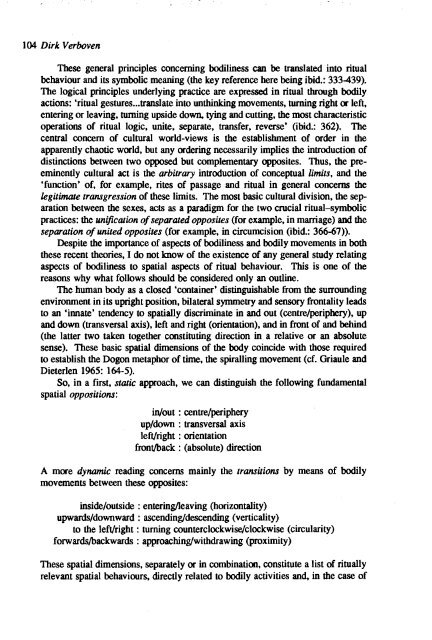1991 No. 1 CONTENTS - Institute of Social and Cultural ...
1991 No. 1 CONTENTS - Institute of Social and Cultural ...
1991 No. 1 CONTENTS - Institute of Social and Cultural ...
You also want an ePaper? Increase the reach of your titles
YUMPU automatically turns print PDFs into web optimized ePapers that Google loves.
104 Dirk Verboven<br />
These general principles concerning bodiliness can be· translated into ritual<br />
behaviour <strong>and</strong> its symbolic meaning (the key reference here being ibid.: 333439).<br />
The logical principles underlying practice are expressed in ritual through bodily<br />
actions: 'ritual gestures ... translate into unthinking movements, turning right or left,<br />
entering or leaving, turning upside do~ tying <strong>and</strong> cutting, the most characteristic<br />
operations <strong>of</strong> ritual logic, unite, separate, transfer, reverse' (ibid.: 362). The<br />
central concern <strong>of</strong> cultural world-views is the establishment <strong>of</strong> order in the<br />
apparently chaotic world, but any ordering necessarily implies the introduction <strong>of</strong><br />
distinctions between two opposed but complementary opposites. Thus, the preeminently<br />
cultural act is the arbitrary introduction <strong>of</strong> conceptual limits, <strong>and</strong> the<br />
'function' <strong>of</strong>, for example, rites <strong>of</strong> passage <strong>and</strong> ritual in general concerns the<br />
legitimate transgression <strong>of</strong> these limits. The most basic cultural division, the separation<br />
between the sexes, acts as a paradigm for the two crucial ritual-symbolic<br />
practices: the unification <strong>of</strong> separated opposites (for example, in marriage) <strong>and</strong> the<br />
separation <strong>of</strong> united opposites (for example, in circumcision (ibid.: 366-67».<br />
Despite the importance <strong>of</strong> aspects <strong>of</strong> bodiliness <strong>and</strong> bodily movements in both<br />
these recent theories, I do not know <strong>of</strong> the existence <strong>of</strong> any general study relating<br />
aspects <strong>of</strong> bodiliness to spatial aspects <strong>of</strong> ritual behaviour. This is one <strong>of</strong> the<br />
reasons why what follows should be considered only an outline.<br />
The human body as a closed 'container' distinguishable from the surrounding<br />
environment in its upright position, bilateral symmetry <strong>and</strong> sensory frontality leads<br />
to an 'innate' tendency to spatially discriminate in <strong>and</strong> out (centre/periphery), up<br />
<strong>and</strong> down (transversal axis), left <strong>and</strong> right (orientation), <strong>and</strong> in front <strong>of</strong> <strong>and</strong> behind<br />
(the latter two taken together constituting direction in a relative or an absolute<br />
sense). These basic spatial dimensions <strong>of</strong> the body coincide with those required<br />
to establish the Dogon metaphor <strong>of</strong> time, the spiralling movement (cf. Griaule <strong>and</strong><br />
Dieterlen 1965: 164-5).<br />
So, in a rust, static approach, we can distinguish the following fundamental<br />
spatial oppositions:<br />
inlout : centre/periphery<br />
up/down : transversal axis<br />
left/right : orientation<br />
front/back : (absolute) direction<br />
A more dynamic reading concerns mainly the transitions by means <strong>of</strong> bodily<br />
movements between these opposites:<br />
inside/outside: entering/leaving (horizontality)<br />
upwards/downward: ascending/descending (verticality)<br />
to the left/right: turning counterclockwise/clockwise (circularity)<br />
forwards/backwards : approaching/withdrawing (proximity)<br />
These spatial dimensions, separately or in combination, constitute a list <strong>of</strong> ritually<br />
relevant spatial behaviours, directly related to bodily activities <strong>and</strong>, in the case <strong>of</strong>
















